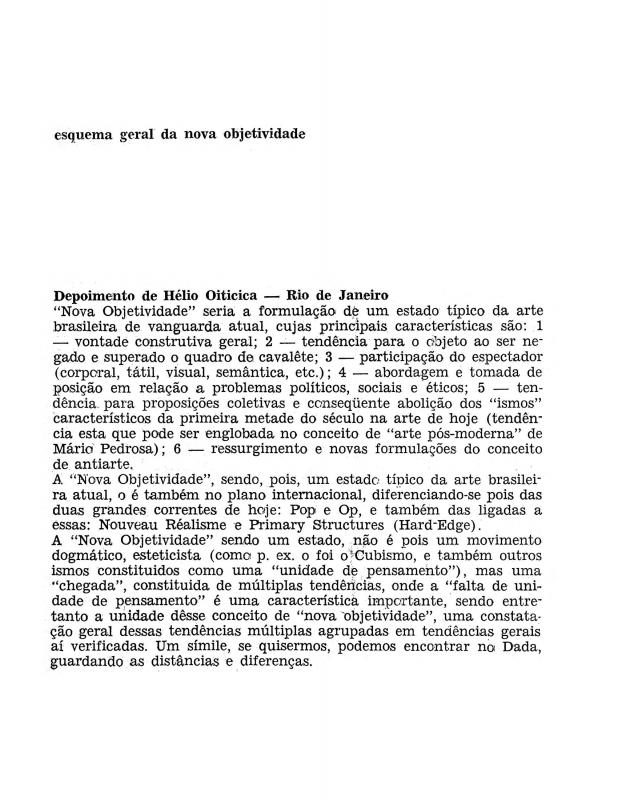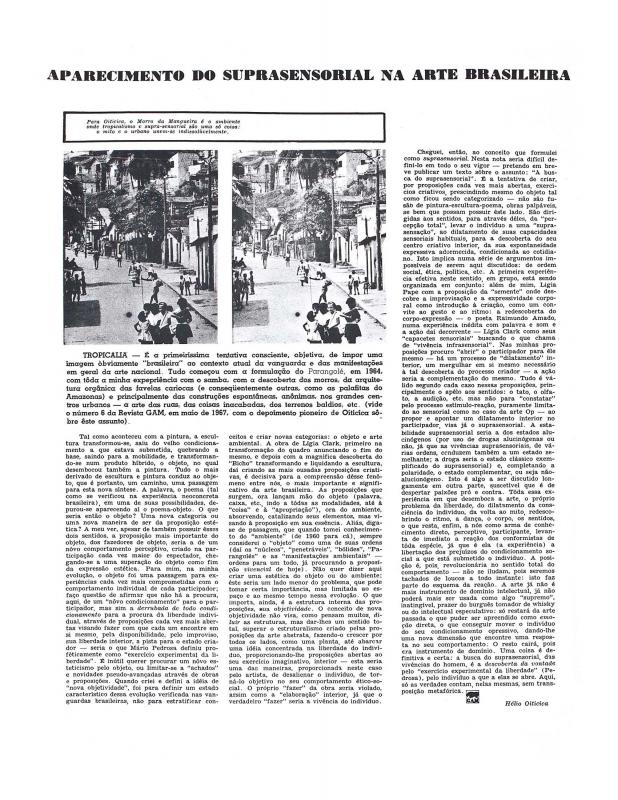Hélio Oiticica suggested “Nova Objetividade Brasileira” as a name to describe a Brazilian avant-garde period that would, in his opinion, be defined by: a general constructive purpose, a focus on the object, the involvement of the viewer in the work of art, a point of view concerning the country’s ethical and socio-political problems (three years after the military coup that was beginning to suspend civil rights), and innovative interpretations of the concept of “anti-art.” Oiticica is convinced that there is a differentiation being processed at an international level, a focal point for multiple avant-garde movements, which coincides with the pioneering views of the critic Mário Pedrosa (1900–81): the notion of “postmodern art” that was already being discussed in 1967. Oiticica also considers the potential of the concept of “(cultural) anthropophagy” suggested by the modernist poet Oswald de Andrade (1890–1954) as a basic tool for Brazilian constructive goals. In conclusion, the author identifies the participating artists and the works that each submitted to the exhibition.
Hélio Oiticica (1937–80) was a Brazilian Neo-Concrete artist. He started studying painting with Ivan Serpa in 1954 at the Museu de Arte Moderna do Rio de Janeiro. He later joined the Grupo Frente and the Neo-Concrete movement. In addition to his geometric paintings, which he worked on while he was studying with Serpa and was a member of the Grupo Frente, Oiticica produced performance and participatory art. His Parangolés (1964)—capes made with fabrics and recycled materials—were worn by the Mangueira Samba School during their performances. Oiticica also created immersive spaces, such as Nucleus (1959–60), which was an installation constructed from suspended painted wooden slats inspired by the Constructivism of Piet Mondrian. In 1967 Oiticica created the immersive environment Tropicália at the Museum of Modern Art in Rio de Janeiro. Tropicália was an installation consisting of rooms with plants and materials such as water, sand and stones, a parrot, a television set, and various other elements that were representative of Brazilian popular culture. The environment was designed to promote sensory stimulation. Oiticica applied the same principles to Eden, the installation he created in 1969 at the Whitechapel Gallery in London. The name Tropicália was used by Brazilian musicians to describe a new style that combined international music and pop with traditional Brazilian music. The term “Tropicália” was absorbed into popular Brazilian culture and came to signify a uniquely Brazilian essence. In 1970 Oiticica took part in the group exhibition Information at the Museum of Modern Art in New York.
For more examples of Oiticica’s thoughts on Brazilian art in the late 1960s and early 1970s, see the essay “Esquema geral da nova objetividade” [doc. no. 1110372], and the article “Aparecimento do suprasensorial na arte brasileira” [doc. no. 1110620].


